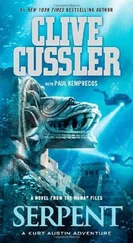Mark Abernethy - Golden Serpent
Здесь есть возможность читать онлайн «Mark Abernethy - Golden Serpent» весь текст электронной книги совершенно бесплатно (целиком полную версию без сокращений). В некоторых случаях можно слушать аудио, скачать через торрент в формате fb2 и присутствует краткое содержание. Жанр: Триллер, на английском языке. Описание произведения, (предисловие) а так же отзывы посетителей доступны на портале библиотеки ЛибКат.
- Название:Golden Serpent
- Автор:
- Жанр:
- Год:неизвестен
- ISBN:нет данных
- Рейтинг книги:5 / 5. Голосов: 1
-
Избранное:Добавить в избранное
- Отзывы:
-
Ваша оценка:
- 100
- 1
- 2
- 3
- 4
- 5
Golden Serpent: краткое содержание, описание и аннотация
Предлагаем к чтению аннотацию, описание, краткое содержание или предисловие (зависит от того, что написал сам автор книги «Golden Serpent»). Если вы не нашли необходимую информацию о книге — напишите в комментариях, мы постараемся отыскать её.
Golden Serpent — читать онлайн бесплатно полную книгу (весь текст) целиком
Ниже представлен текст книги, разбитый по страницам. Система сохранения места последней прочитанной страницы, позволяет с удобством читать онлайн бесплатно книгу «Golden Serpent», без необходимости каждый раз заново искать на чём Вы остановились. Поставьте закладку, и сможете в любой момент перейти на страницу, на которой закончили чтение.
Интервал:
Закладка:
‘Hazardous Cargo Control area.’
‘That’s the one, HCC. I’d say the VX will be in the same container your Technical Escort guys loaded it into. It’ll just have new, non-military markings and it may have been painted.’
‘I don’t follow how Sabaya could defeat the microdot tracking,’ said Don. ‘What’s this about degaussing?’
Mac wasn’t much of a scientist, but he could give the basics.
‘Well, every steel structure has an electromagnetic current running through it, and it runs in one direction which creates what they call a signature.’
‘Like a ship?’ asked Don.
‘Yeah. And you can change the current and therefore the signature by introducing electromagnets and strategic copper coils. Navies do it to defeat signals intelligence on their ships and subs.’
‘So…?’
‘So the container pirates in this part of the world use degaussing on containers, and if they get it right it defeats the microdots. You can’t track them.’
Don and Hatfi eld glared at one another.
‘So the agent is still in the same box?’ asked Hatfi eld.
‘That’s the Sabaya MO, sir. There’s about twenty million containers in circulation around the globe with an annual theft rate of four per cent. This is happening all the time.’
Don couldn’t grasp it. ‘Why wouldn’t they take the material out of the container and put it somewhere else?’
‘Because Sabaya isn’t a terrorist in the traditional sense,’ said Mac.
‘He’s not on a suicide mission, he wants to make money. So he makes it easy for himself and pulls a sort of three-card trick. You know those guys on the corner?’
‘Yep, sure do,’ smiled Don.
‘That’s what Sabaya does. The container doesn’t get opened. Who’d want to try and open a container full of nerve agent?’
The group nodded.
‘The container just gets put somewhere else. It’s just another container box, going onto a ship, coming off a ship, being stacked.
It’s just that they think it’s something else.’
‘So where does it go?’
‘It goes on to a different ship at Manila, but with a new RFID tag on it. A legit RFID tag. A tag that the stevedores can tick off as belonging on the ship they are loading.’
The RFID tags sealed most containers going between major ports.
They identifi ed the container and included an electronic manifest which could be checked by scanning. They were ‘sealed’ onto the container doors so an RFID tag meant that the shipping company and freight forwarders certifi ed what was inside. The US Department of Defense sealed all its containers with proprietary RFIDs. Mac knew you couldn’t ship a container through MICT without such a tag.
‘The DoD container with the new tag is shipped to another port where it comes off as a legitimate container and can be moved to a warehouse somewhere. You let the shipping system work for you. That’s how most heists now work across South-East Asia.’
‘That easy? Can’t be that easy,’ said Don, sceptical.
Mac gave them the example of a car with a tollway e-tag on the windscreen. The tag is registered to the car. But if someone took the e-tag off that car and put it on another, the electronic scanners would record that the original car had gone through the toll gates. It was the same with RFID tags on containers.
‘There is a catch,’ said Mac.
‘What’s that?’ asked Hatfi eld.
‘Catch is, General, that I need two things to do this properly. I need someone on the inside, down at MICT, to do the actual switcheroo.
It should take fi ve, ten minutes. Second, I need to have another RFID tag to seal that box. And it will have to match with what the Customs guys at Surabaya are expecting. This only works if I have a mimic of what the next port is expecting. So I need to fi nd a real container with a real RFID tag going to a real location. And then steal it.’
‘Actually,’ said Don, ‘we’ve been using smart boxes on those shipments. We’d get a tip-off if they were being tampered with.’
Mac nibbled on his bottom lip. Looked at Sawtell as if to say sorry.
The smart boxes were an American attempt to stop container heists and terrorist infi ltrations via container. They combined RFID tags and seals, GPS location beacons, and anti-tamper sensors, all built into a single anti-tamper box bolted to the container. They were the new wave in maritime security.
But they had a simple weakness.
‘I’m here without prejudice, right?’ said Mac to Hatfi eld.
‘My personal guarantee.’
Don turned his hands up, looking to the other Yanks for help. His look said, Who is this guy?
‘Well, smart boxes are driven by a boxful of C-size batteries,’ said Mac.
‘Are they?’ said Hatfi eld.
‘Um, yeah, and it doesn’t take much to shut down a bunch of C-size batteries. Decent magnet will do it.’
Hatfi eld looked at Don, aghast. ‘That could be why we’ve lost Box 138 off the screens, hey fellas?’
Sawtell gave Mac a look. Mac shrugged. Yanks might as well know this stuff.
CHAPTER 29
The group tore south out of the Macassar Strait and into the stretch of ocean separating Java from Borneo. If you were ever going to be accosted on the high seas by smiling looters with sarungs and AK-47s, the scimitar-shaped body of water where the Macassar Strait turned west into the Java Sea was where it was most likely to happen.
The CH-47D Chinooks fl ew line astern; the four Black Hawks fl ying abreast in a stagger, creating an arrow-head effect. The sea was only fi fty feet below the Chinook Mac was in, pitch-black except for the intermittent fl ash of red aviation lights. The Chinook thromped, its turbine exhausts whining. Mac sat around the situation table with Don and Hatfi eld, having briefed them on the CL-20. They were still amazed that so much of the stuff was in one place, astonished it was being hauled around in gear bags in a speedboat.
‘I’d love to know where all that CL-20 came from,’ said Don as if Mac might have the answer, just like he knew how to kill battery power in the smart boxes. Mac wasn’t going to hurt Don’s image even more by admitting that most of his shipping knowledge came from a female Aussie cop.
Behind them, the guy called Brown was working on screens and liaising with Manila over his headset. Brown’s subordinate had a big real-time screen with a bunch of white cigars on it. The major shipping companies had GPS locators on them and each of the white cigars had a small legend beside it which identifi ed the vessel with a series of letters and numbers.
Mac had suggested they work back, get Manila International to fi nd the orphan container left somewhere on the docks, the one with no RFID tag. Maybe also stripped of markings, maybe not. Then see what ship it was supposed to be on. It wouldn’t be able to leave the MICT apron because the security gate would impound a container that was supposed to have an RFID tag, but didn’t.
It was going to be a long search. MICT turned over about four thousand containers each day. The unions and management were on performance markers for their pay and, given that Manila had already had their hassles with the Americans, they were probably not going to drop everything and go looking for one untagged container in a seventy-fi ve-hectare storage area. Not when it was the Americans’ own fault. Mac reckoned if Sabaya’s team had done their job, it would take a week to fi nd that container, which was an unmarked red forty-footer. Just about the most common sight you’d see on a dock or container ship.
The guys on Hatfi eld’s Chinook worked forwards too. Hatfi eld and Don had the sailing schedules of eight ships that had left Manila in the last eighteen hours, south-bound through the Sulu Sea to Surabaya or Lombok. There was a list of the vessels sitting in front of Hatfi eld. Mac was still betting it would be Surabaya. Lombok was busy but it still largely serviced ‘feeder’ container ships which also carried loose freight. Surabaya was more likely to service a large container ship from MICT.
Читать дальшеИнтервал:
Закладка:
Похожие книги на «Golden Serpent»
Представляем Вашему вниманию похожие книги на «Golden Serpent» списком для выбора. Мы отобрали схожую по названию и смыслу литературу в надежде предоставить читателям больше вариантов отыскать новые, интересные, ещё непрочитанные произведения.
Обсуждение, отзывы о книге «Golden Serpent» и просто собственные мнения читателей. Оставьте ваши комментарии, напишите, что Вы думаете о произведении, его смысле или главных героях. Укажите что конкретно понравилось, а что нет, и почему Вы так считаете.











